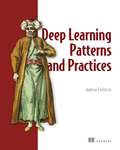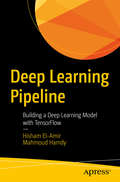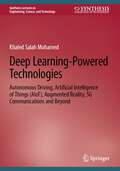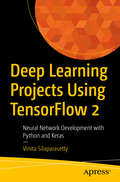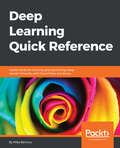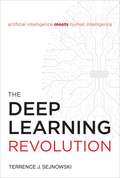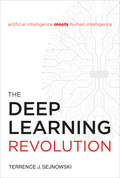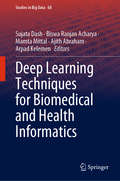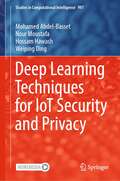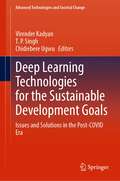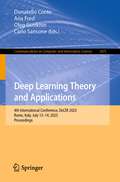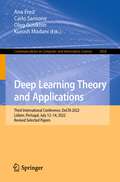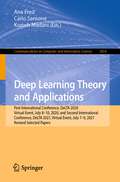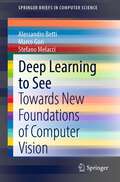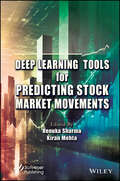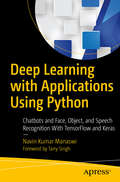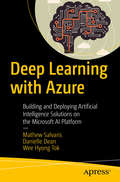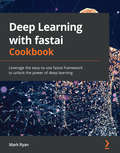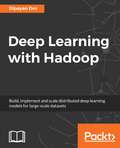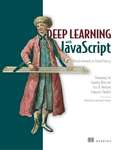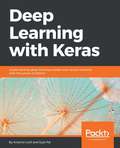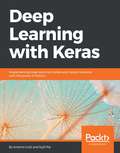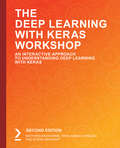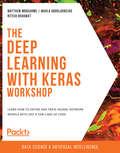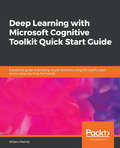- Table View
- List View
Deep Learning Patterns and Practices
by Andrew FerlitschDiscover best practices, reproducible architectures, and design patterns to help guide deep learning models from the lab into production.In Deep Learning Patterns and Practices you will learn: Internal functioning of modern convolutional neural networks Procedural reuse design pattern for CNN architectures Models for mobile and IoT devices Assembling large-scale model deployments Optimizing hyperparameter tuning Migrating a model to a production environment The big challenge of deep learning lies in taking cutting-edge technologies from R&D labs through to production. Deep Learning Patterns and Practices is here to help. This unique guide lays out the latest deep learning insights from author Andrew Ferlitsch&’s work with Google Cloud AI. In it, you'll find deep learning models presented in a unique new way: as extendable design patterns you can easily plug-and-play into your software projects. Each valuable technique is presented in a way that's easy to understand and filled with accessible diagrams and code samples. Purchase of the print book includes a free eBook in PDF, Kindle, and ePub formats from Manning Publications. About the technology Discover best practices, design patterns, and reproducible architectures that will guide your deep learning projects from the lab into production. This awesome book collects and illuminates the most relevant insights from a decade of real world deep learning experience. You&’ll build your skills and confidence with each interesting example. About the book Deep Learning Patterns and Practices is a deep dive into building successful deep learning applications. You&’ll save hours of trial-and-error by applying proven patterns and practices to your own projects. Tested code samples, real-world examples, and a brilliant narrative style make even complex concepts simple and engaging. Along the way, you&’ll get tips for deploying, testing, and maintaining your projects. What's inside Modern convolutional neural networks Design pattern for CNN architectures Models for mobile and IoT devices Large-scale model deployments Examples for computer vision About the reader For machine learning engineers familiar with Python and deep learning. About the author Andrew Ferlitsch is an expert on computer vision, deep learning, and operationalizing ML in production at Google Cloud AI Developer Relations. Table of Contents PART 1 DEEP LEARNING FUNDAMENTALS 1 Designing modern machine learning 2 Deep neural networks 3 Convolutional and residual neural networks 4 Training fundamentals PART 2 BASIC DESIGN PATTERN 5 Procedural design pattern 6 Wide convolutional neural networks 7 Alternative connectivity patterns 8 Mobile convolutional neural networks 9 Autoencoders PART 3 WORKING WITH PIPELINES 10 Hyperparameter tuning 11 Transfer learning 12 Data distributions 13 Data pipeline 14 Training and deployment pipeline
Deep Learning Pipeline: Building a Deep Learning Model with TensorFlow
by Hisham El-Amir Mahmoud HamdyBuild your own pipeline based on modern TensorFlow approaches rather than outdated engineering concepts. This book shows you how to build a deep learning pipeline for real-life TensorFlow projects. You'll learn what a pipeline is and how it works so you can build a full application easily and rapidly. Then troubleshoot and overcome basic Tensorflow obstacles to easily create functional apps and deploy well-trained models. Step-by-step and example-oriented instructions help you understand each step of the deep learning pipeline while you apply the most straightforward and effective tools to demonstrative problems and datasets. You'll also develop a deep learning project by preparing data, choosing the model that fits that data, and debugging your model to get the best fit to data all using Tensorflow techniques. Enhance your skills by accessing some of the most powerful recent trends in data science. If you've ever considered building your own image or text-tagging solution or entering a Kaggle contest, Deep Learning Pipeline is for you! What You'll LearnDevelop a deep learning project using dataStudy and apply various models to your dataDebug and troubleshoot the proper model suited for your dataWho This Book Is ForDevelopers, analysts, and data scientists looking to add to or enhance their existing skills by accessing some of the most powerful recent trends in data science. Prior experience in Python or other TensorFlow related languages and mathematics would be helpful.
Deep Learning-Powered Technologies: Autonomous Driving, Artificial Intelligence of Things (AIoT), Augmented Reality, 5G Communications and Beyond (Synthesis Lectures on Engineering, Science, and Technology)
by Khaled Salah MohamedThis book covers various, leading-edge deep learning technologies. The author discusses new applications of deep learning and gives insight into the integration of deep learning with various application domains, such as autonomous driving, augmented reality, AIOT, 5G and beyond.
Deep Learning Projects Using TensorFlow 2: Neural Network Development with Python and Keras
by Vinita SilaparasettyWork through engaging and practical deep learning projects using TensorFlow 2.0. Using a hands-on approach, the projects in this book will lead new programmers through the basics into developing practical deep learning applications. Deep learning is quickly integrating itself into the technology landscape. Its applications range from applicable data science to deep fakes and so much more. It is crucial for aspiring data scientists or those who want to enter the field of AI to understand deep learning concepts. The best way to learn is by doing. You'll develop a working knowledge of not only TensorFlow, but also related technologies such as Python and Keras. You'll also work with Neural Networks and other deep learning concepts. By the end of the book, you'll have a collection of unique projects that you can add to your GitHub profiles and expand on for professional application. What You'll LearnGrasp the basic process of neural networks through projects, such as creating musicRestore and colorize black and white images with deep learning processesWho This Book Is ForBeginners new to TensorFlow and Python.
Deep Learning Quick Reference: Useful hacks for training and optimizing deep neural networks with TensorFlow and Keras
by Michael BernicoDive deeper into neural networks and get your models trained, optimized with this quick reference guideKey FeaturesA quick reference to all important deep learning concepts and their implementationsEssential tips, tricks, and hacks to train a variety of deep learning models such as CNNs, RNNs, LSTMs, and moreSupplemented with essential mathematics and theory, every chapter provides best practices and safe choices for training and fine-tuning your models in Keras and Tensorflow.Book DescriptionDeep learning has become an essential necessity to enter the world of artificial intelligence. With this book deep learning techniques will become more accessible, practical, and relevant to practicing data scientists. It moves deep learning from academia to the real world through practical examples.You will learn how Tensor Board is used to monitor the training of deep neural networks and solve binary classification problems using deep learning. Readers will then learn to optimize hyperparameters in their deep learning models. The book then takes the readers through the practical implementation of training CNN's, RNN's, and LSTM's with word embeddings and seq2seq models from scratch. Later the book explores advanced topics such as Deep Q Network to solve an autonomous agent problem and how to use two adversarial networks to generate artificial images that appear real. For implementation purposes, we look at popular Python-based deep learning frameworks such as Keras and Tensorflow, Each chapter provides best practices and safe choices to help readers make the right decision while training deep neural networks.By the end of this book, you will be able to solve real-world problems quickly with deep neural networks.What you will learn Solve regression and classification challenges with TensorFlow and Keras Learn to use Tensor Board for monitoring neural networks and its training Optimize hyperparameters and safe choices/best practices Build CNN's, RNN's, and LSTM's and using word embedding from scratch Build and train seq2seq models for machine translation and chat applications. Understanding Deep Q networks and how to use one to solve an autonomous agent problem. Explore Deep Q Network and address autonomous agent challenges.Who this book is forIf you are a Data Scientist or a Machine Learning expert, then this book is a very useful read in training your advanced machine learning and deep learning models. You can also refer this book if you are stuck in-between the neural network modeling and need immediate assistance in getting accomplishing the task smoothly. Some prior knowledge of Python and tight hold on the basics of machine learning is required.
The Deep Learning Revolution
by Terrence J. SejnowskiSejnowski played an important role in the founding of deep learning, as one of a small group of researchers in the 1980s who challenged the prevailing logic-and-symbol based version of AI. The new version of AI Sejnowski and others developed, which became deep learning, is fueled instead by data..
The Deep Learning Revolution (The\mit Press Ser.)
by Terrence J. SejnowskiHow deep learning—from Google Translate to driverless cars to personal cognitive assistants—is changing our lives and transforming every sector of the economy.The deep learning revolution has brought us driverless cars, the greatly improved Google Translate, fluent conversations with Siri and Alexa, and enormous profits from automated trading on the New York Stock Exchange. Deep learning networks can play poker better than professional poker players and defeat a world champion at Go. In this book, Terry Sejnowski explains how deep learning went from being an arcane academic field to a disruptive technology in the information economy.Sejnowski played an important role in the founding of deep learning, as one of a small group of researchers in the 1980s who challenged the prevailing logic-and-symbol based version of AI. The new version of AI Sejnowski and others developed, which became deep learning, is fueled instead by data. Deep networks learn from data in the same way that babies experience the world, starting with fresh eyes and gradually acquiring the skills needed to navigate novel environments. Learning algorithms extract information from raw data; information can be used to create knowledge; knowledge underlies understanding; understanding leads to wisdom. Someday a driverless car will know the road better than you do and drive with more skill; a deep learning network will diagnose your illness; a personal cognitive assistant will augment your puny human brain. It took nature many millions of years to evolve human intelligence; AI is on a trajectory measured in decades. Sejnowski prepares us for a deep learning future.
Deep Learning Techniques for Biomedical and Health Informatics (Studies in Big Data #68)
by Sujata Dash Biswa Ranjan Acharya Mamta Mittal Ajith Abraham Arpad KelemenThis book presents a collection of state-of-the-art approaches for deep-learning-based biomedical and health-related applications. The aim of healthcare informatics is to ensure high-quality, efficient health care, and better treatment and quality of life by efficiently analyzing abundant biomedical and healthcare data, including patient data and electronic health records (EHRs), as well as lifestyle problems. In the past, it was common to have a domain expert to develop a model for biomedical or health care applications; however, recent advances in the representation of learning algorithms (deep learning techniques) make it possible to automatically recognize the patterns and represent the given data for the development of such model. This book allows new researchers and practitioners working in the field to quickly understand the best-performing methods. It also enables them to compare different approaches and carry forward their research in an important area that has a direct impact on improving the human life and health. It is intended for researchers, academics, industry professionals, and those at technical institutes and R&D organizations, as well as students working in the fields of machine learning, deep learning, biomedical engineering, health informatics, and related fields.
Deep Learning Techniques for IoT Security and Privacy (Studies in Computational Intelligence #997)
by Mohamed Abdel-Basset Nour Moustafa Hossam Hawash Weiping DingThis book states that the major aim audience are people who have some familiarity with Internet of things (IoT) but interested to get a comprehensive interpretation of the role of deep Learning in maintaining the security and privacy of IoT. A reader should be friendly with Python and the basics of machine learning and deep learning. Interpretation of statistics and probability theory will be a plus but is not certainly vital for identifying most of the book's material.
Deep Learning Technologies for the Sustainable Development Goals: Issues and Solutions in the Post-COVID Era (Advanced Technologies and Societal Change)
by Virender Kadyan T. P. Singh Chidiebere UgwuThis book provides insights into deep learning techniques that impact the implementation strategies toward achieving the Sustainable Development Goals (SDGs) laid down by the United Nations for its 2030 agenda, elaborating on the promises, limits, and the new challenges. It also covers the challenges, hurdles, and opportunities in various applications of deep learning for the SDGs. A comprehensive survey on the major applications and research, based on deep learning techniques focused on SDGs through speech and image processing, IoT, security, AR-VR, formal methods, and blockchain, is a feature of this book. In particular, there is a need to extend research into deep learning and its broader application to many sectors and to assess its impact on achieving the SDGs. The chapters in this book help in finding the use of deep learning across all sections of SDGs. The rapid development of deep learning needs to be supported by the organizational insight and oversight necessary for AI-based technologies in general; hence, this book presents and discusses the implications of how deep learning enables the delivery agenda for sustainable development.
Deep Learning Theory and Applications: 4th International Conference, DeLTA 2023, Rome, Italy, July 13–14, 2023, Proceedings (Communications in Computer and Information Science #1875)
by Donatello Conte Ana Fred Oleg Gusikhin Carlo SansoneThis book consitiutes the refereed proceedings of the 4th International Conference on Deep Learning Theory and Applications, DeLTA 2023, held in Rome, Italy from 13 to 14 July 2023.The 9 full papers and 22 short papers presented were thoroughly reviewed and selected from the 42 qualified submissions. The scope of the conference includes such topics as models and algorithms; machine learning; big data analytics; computer vision applications; and natural language understanding.
Deep Learning Theory and Applications: Third International Conference, DeLTA 2022, Lisbon, Portugal, July 12–14, 2022, Revised Selected Papers (Communications in Computer and Information Science #1858)
by Ana Fred Carlo Sansone Oleg Gusikhin Kurosh MadaniThis book constitutes the refereed post-conference proceedings of the Third International Conference on Deep Learning Theory and Applications, DeLTA 2022, held in Lisbon, Portugal, during January 17-18, 2022.The 6 full papers included in this book were carefully reviewed and selected from 36 submissions. They present recent research on machine learning and artificial intelligence in real-world applications such as computer vision, information retrieval and summarization from structured and unstructured multimodal data sources, natural language understanding and translation, and many other application domains.
Deep Learning Theory and Applications: First International Conference, DeLTA 2020, Virtual Event, July 8-10, 2020, and Second International Conference, DeLTA 2021, Virtual Event, July 7–9, 2021, Revised Selected Papers (Communications in Computer and Information Science #1854)
by Ana Fred Carlo Sansone Kurosh MadaniThis book constitutes the refereed post-proceedings of the First International Conference and Second International Conference on Deep Learning Theory and Applications, DeLTA 2020 and DeLTA 2021, was held virtually due to the COVID-19 crisis on July 8-10, 2020 and July 7–9, 2021.The 7 full papers included in this book were carefully reviewed and selected from 58 submissions. They present recent research on machine learning and artificial intelligence in real-world applications such as computer vision, information retrieval and summarization from structuredand unstructured multimodal data sources, natural language understanding andtranslation, and many other application domains.
Deep Learning to See: Towards New Foundations of Computer Vision (SpringerBriefs in Computer Science)
by Alessandro Betti Marco Gori Stefano MelacciThe remarkable progress in computer vision over the last few years is, by and large, attributed to deep learning, fueled by the availability of huge sets of labeled data, and paired with the explosive growth of the GPU paradigm. While subscribing to this view, this work criticizes the supposed scientific progress in the field, and proposes the investigation of vision within the framework of information-based laws of nature. This work poses fundamental questions about vision that remain far from understood, leading the reader on a journey populated by novel challenges resonating with the foundations of machine learning. The central thesis proposed is that for a deeper understanding of visual computational processes, it is necessary to look beyond the applications of general purpose machine learning algorithms, and focus instead on appropriate learning theories that take into account the spatiotemporal nature of the visual signal.Serving to inspire and stimulate critical reflection and discussion, yet requiring no prior advanced technical knowledge, the text can naturally be paired with classic textbooks on computer vision to better frame the current state of the art, open problems, and novel potential solutions. As such, it will be of great benefit to graduate and advanced undergraduate students in computer science, computational neuroscience, physics, and other related disciplines.
Deep Learning Tools for Predicting Stock Market Movements
by Renuka Sharma Kiran MehtaDEEP LEARNING TOOLS for PREDICTING STOCK MARKET MOVEMENTS The book provides a comprehensive overview of current research and developments in the field of deep learning models for stock market forecasting in the developed and developing worlds. The book delves into the realm of deep learning and embraces the challenges, opportunities, and transformation of stock market analysis. Deep learning helps foresee market trends with increased accuracy. With advancements in deep learning, new opportunities in styles, tools, and techniques evolve and embrace data-driven insights with theories and practical applications. Learn about designing, training, and applying predictive models with rigorous attention to detail. This book offers critical thinking skills and the cultivation of discerning approaches to market analysis. The book: details the development of an ensemble model for stock market prediction, combining long short-term memory and autoregressive integrated moving average; explains the rapid expansion of quantum computing technologies in financial systems; provides an overview of deep learning techniques for forecasting stock market trends and examines their effectiveness across different time frames and market conditions; explores applications and implications of various models for causality, volatility, and co-integration in stock markets, offering insights to investors and policymakers. Audience The book has a wide audience of researchers in financial technology, financial software engineering, artificial intelligence, professional market investors, investment institutions, and asset management companies.
Deep Learning with Applications Using Python: Chatbots And Face, Object, And Speech Recognition With Tensorflow And Keras
by Navin Kumar ManaswiExplore deep learning applications, such as computer vision, speech recognition, and chatbots, using frameworks such as TensorFlow and Keras. This book helps you to ramp up your practical know-how in a short period of time and focuses you on the domain, models, and algorithms required for deep learning applications. Deep Learning with Applications Using Python covers topics such as chatbots, natural language processing, and face and object recognition. The goal is to equip you with the concepts, techniques, and algorithm implementations needed to create programs capable of performing deep learning.This book covers convolutional neural networks, recurrent neural networks, and multilayer perceptrons. It also discusses popular APIs such as IBM Watson, Microsoft Azure, and scikit-learn. What You Will Learn Work with various deep learning frameworks such as TensorFlow, Keras, and scikit-learn.Use face recognition and face detection capabilitiesCreate speech-to-text and text-to-speech functionalityEngage with chatbots using deep learningWho This Book Is ForData scientists and developers who want to adapt and build deep learning applications.
Deep Learning with Azure: Building and Deploying Artificial Intelligence Solutions on the Microsoft AI Platform
by Wee Hyong Tok Mathew Salvaris Danielle DeanGet up-to-speed with Microsoft's AI Platform. Learn to innovate and accelerate with open and powerful tools and services that bring artificial intelligence to every data scientist and developer.Artificial Intelligence (AI) is the new normal. Innovations in deep learning algorithms and hardware are happening at a rapid pace. It is no longer a question of should I build AI into my business, but more about where do I begin and how do I get started with AI?Written by expert data scientists at Microsoft, Deep Learning with the Microsoft AI Platform helps you with the how-to of doing deep learning on Azure and leveraging deep learning to create innovative and intelligent solutions. Benefit from guidance on where to begin your AI adventure, and learn how the cloud provides you with all the tools, infrastructure, and services you need to do AI.What You'll LearnBecome familiar with the tools, infrastructure, and services available for deep learning on Microsoft Azure such as Azure Machine Learning services and Batch AIUse pre-built AI capabilities (Computer Vision, OCR, gender, emotion, landmark detection, and more)Understand the common deep learning models, including convolutional neural networks (CNNs), recurrent neural networks (RNNs), generative adversarial networks (GANs) with sample code and understand how the field is evolvingDiscover the options for training and operationalizing deep learning models on AzureWho This Book Is ForProfessional data scientists who are interested in learning more about deep learning and how to use the Microsoft AI platform. Some experience with Python is helpful.
Deep Learning with fastai Cookbook: Leverage the easy-to-use fastai framework to unlock the power of deep learning
by Mark RyanHarness the power of the easy-to-use, high-performance fastai framework to rapidly create complete deep learning solutions with few lines of codeKey FeaturesDiscover how to apply state-of-the-art deep learning techniques to real-world problemsBuild and train neural networks using the power and flexibility of the fastai frameworkUse deep learning to tackle problems such as image classification and text classificationBook Descriptionfastai is an easy-to-use deep learning framework built on top of PyTorch that lets you rapidly create complete deep learning solutions with as few as 10 lines of code. Both predominant low-level deep learning frameworks, TensorFlow and PyTorch, require a lot of code, even for straightforward applications. In contrast, fastai handles the messy details for you and lets you focus on applying deep learning to actually solve problems.The book begins by summarizing the value of fastai and showing you how to create a simple 'hello world' deep learning application with fastai. You'll then learn how to use fastai for all four application areas that the framework explicitly supports: tabular data, text data (NLP), recommender systems, and vision data. As you advance, you'll work through a series of practical examples that illustrate how to create real-world applications of each type. Next, you'll learn how to deploy fastai models, including creating a simple web application that predicts what object is depicted in an image. The book wraps up with an overview of the advanced features of fastai.By the end of this fastai book, you'll be able to create your own deep learning applications using fastai. You'll also have learned how to use fastai to prepare raw datasets, explore datasets, train deep learning models, and deploy trained models.What you will learnPrepare real-world raw datasets to train fastai deep learning modelsTrain fastai deep learning models using text and tabular dataCreate recommender systems with fastaiFind out how to assess whether fastai is a good fit for a given problemDeploy fastai deep learning models in web applicationsTrain fastai deep learning models for image classificationWho this book is forThis book is for data scientists, machine learning developers, and deep learning enthusiasts looking to explore the fastai framework using a recipe-based approach. Working knowledge of the Python programming language and machine learning basics is strongly recommended to get the most out of this deep learning book.
Deep Learning with Hadoop
by Dipayan DevIf you are a data scientist who wants to learn how to perform deep learning on Hadoop, this is the book for you. Knowledge of the basic machine learning concepts and some understanding of Hadoop is required to make the best use of this book.
Deep Learning with JavaScript: Neural networks in TensorFlow.js
by Stanley Bileschi Eric Nielsen Shanqing CaiSummary Deep learning has transformed the fields of computer vision, image processing, and natural language applications. Thanks to TensorFlow.js, now JavaScript developers can build deep learning apps without relying on Python or R. Deep Learning with JavaScript shows developers how they can bring DL technology to the web. Written by the main authors of the TensorFlow library, this new book provides fascinating use cases and in-depth instruction for deep learning apps in JavaScript in your browser or on Node. Foreword by Nikhil Thorat and Daniel Smilkov. About the technology Running deep learning applications in the browser or on Node-based backends opens up exciting possibilities for smart web applications. With the TensorFlow.js library, you build and train deep learning models with JavaScript. Offering uncompromising production-quality scalability, modularity, and responsiveness, TensorFlow.js really shines for its portability. Its models run anywhere JavaScript runs, pushing ML farther up the application stack. About the book In Deep Learning with JavaScript, you&’ll learn to use TensorFlow.js to build deep learning models that run directly in the browser. This fast-paced book, written by Google engineers, is practical, engaging, and easy to follow. Through diverse examples featuring text analysis, speech processing, image recognition, and self-learning game AI, you&’ll master all the basics of deep learning and explore advanced concepts, like retraining existing models for transfer learning and image generation. What's inside - Image and language processing in the browser - Tuning ML models with client-side data - Text and image creation with generative deep learning - Source code samples to test and modify About the reader For JavaScript programmers interested in deep learning. About the author Shanging Cai, Stanley Bileschi and Eric D. Nielsen are software engineers with experience on the Google Brain team, and were crucial to the development of the high-level API of TensorFlow.js. This book is based in part on the classic, Deep Learning with Python by François Chollet. TOC: PART 1 - MOTIVATION AND BASIC CONCEPTS 1 • Deep learning and JavaScript PART 2 - A GENTLE INTRODUCTION TO TENSORFLOW.JS 2 • Getting started: Simple linear regression in TensorFlow.js 3 • Adding nonlinearity: Beyond weighted sums 4 • Recognizing images and sounds using convnets 5 • Transfer learning: Reusing pretrained neural networks PART 3 - ADVANCED DEEP LEARNING WITH TENSORFLOW.JS 6 • Working with data 7 • Visualizing data and models 8 • Underfitting, overfitting, and the universal workflow of machine learning 9 • Deep learning for sequences and text 10 • Generative deep learning 11 • Basics of deep reinforcement learning PART 4 - SUMMARY AND CLOSING WORDS 12 • Testing, optimizing, and deploying models 13 • Summary, conclusions, and beyond
Deep Learning with Keras
by Antonio GulliKeras is a high-level neural network library written in Python, and runs on top of either Theano or TensorFlow. It is a minimal, highly modular framework that runs on both CPU and GPU, and allows you to put your ideas into action in the shortest possible time. This book will help you get started with the basics of Keras, in a highly practical manner.
Deep Learning with Keras
by Sujit Pal Antonio GulliGet to grips with the basics of Keras to implement fast and efficient deep-learning models About This Book • Implement various deep-learning algorithms in Keras and see how deep-learning can be used in games • See how various deep-learning models and practical use-cases can be implemented using Keras • A practical, hands-on guide with real-world examples to give you a strong foundation in Keras Who This Book Is For If you are a data scientist with experience in machine learning or an AI programmer with some exposure to neural networks, you will find this book a useful entry point to deep-learning with Keras. A knowledge of Python is required for this book. What You Will Learn • Optimize step-by-step functions on a large neural network using the Backpropagation Algorithm • Fine-tune a neural network to improve the quality of results • Use deep learning for image and audio processing • Use Recursive Neural Tensor Networks (RNTNs) to outperform standard word embedding in special cases • Identify problems for which Recurrent Neural Network (RNN) solutions are suitable • Explore the process required to implement Autoencoders • Evolve a deep neural network using reinforcement learning In Detail This book starts by introducing you to supervised learning algorithms such as simple linear regression, the classical multilayer perceptron and more sophisticated deep convolutional networks. You will also explore image processing with recognition of hand written digit images, classification of images into different categories, and advanced objects recognition with related image annotations. An example of identification of salient points for face detection is also provided. Next you will be introduced to Recurrent Networks, which are optimized for processing sequence data such as text, audio or time series. Following that, you will learn about unsupervised learning algorithms such as Autoencoders and the very popular Generative Adversarial Networks (GAN). You will also explore non-traditional uses of neural networks as Style Transfer. Finally, you will look at Reinforcement Learning and its application to AI game playing, another popular direction of research and application of neural networks. Style and approach This book is an easy-to-follow guide full of examples and real-world applications to help you gain an in-depth understanding of Keras. This book will showcase more than twenty working Deep Neural Networks coded in Python using Keras.
The Deep Learning with Keras Workshop: An Interactive Approach to Understanding Deep Learning with Keras, 2nd Edition
by Ritesh Bhagwat Mahla Abdolahnejad Matthew MoocarmeCut through the noise and get real results with a step-by-step approach to understanding deep learning with Keras programming Key Features Ideal for those getting started with Keras for the first time A step-by-step Keras tutorial with exercises and activities that help build key skills Structured to let you progress at your own pace, on your own terms Use your physical print copy to redeem free access to the online interactive edition Book Description You already know that you want to learn Keras, and a smarter way to learn is to learn by doing. The Deep Learning with Keras Workshop focuses on building up your practical skills so that you can develop artificial intelligence applications or build machine learning models with Keras. You'll learn from real examples that lead to real results. Throughout The Deep Learning with Keras Workshop, you'll take an engaging step-by-step approach to understand Keras. You won't have to sit through any unnecessary theory. If you're short on time you can jump into a single exercise each day or spend an entire weekend tinkering with your own neural networks. It's your choice. Learning on your terms, you'll build up and reinforce key skills in a way that feels rewarding. Every physical print copy of The Deep Learning with Keras Workshop unlocks access to the interactive edition. With videos detailing all exercises and activities, you'll always have a guided solution. You can also benchmark yourself against assessments, track progress, and receive content updates. You'll even earn a secure credential that you can share and verify online upon completion. It's a premium learning experience that's included with your printed copy. To redeem, follow the instructions located at the start of your book. Fast-paced and direct, The Deep Learning with Keras Workshop is the ideal companion for those who are just getting started with Keras. You'll build and iterate on your code like a software developer, learning along the way. This process means that you'll find that your new skills stick, embedded as best practice. A solid foundation for the years ahead. What you will learn Gain insight into the fundamental concepts of neural networks Learn to think like a data scientist and understand the difference between machine learning and deep learning Discover various techniques to evaluate, tweak, and improve your models Explore different techniques to manipulate your data Explore alternative techniques to verify the accuracy of your model Who this book is for Our goal at Packt is to help you be successful, in whatever it is that you choose to do. The Deep Learning with Keras Workshop is an ideal tutorial for the programmer who is getting started with Keras and deep learning. Pick up a Workshop today and let Packt help you develop skills that stick with you for life.
The Deep Learning with Keras Workshop - Third Edition: Solve Complex Real-life Problems With The Simplicity Of Keras
by Mahla Abdolahnejad Matthew MoocarmeIf you know the basics of data science and machine learning, and want to get started with advanced machine learning technologies, such as artificial neural networks and deep learning, this workshop makes it easy. To grasp the concepts explained in this deep learning book more effectively, prior experience in Python programming and some familiarity with statistics and logistic regression are a must.
Deep Learning with Microsoft Cognitive Toolkit Quick Start Guide: A practical guide to building neural networks using Microsoft's open source deep learning framework
by Willem MeintsLearn how to train popular deep learning architectures such as autoencoders, convolutional and recurrent neural networks while discovering how you can use deep learning models in your software applications with Microsoft Cognitive Toolkit Key Features Understand the fundamentals of Microsoft Cognitive Toolkit and set up the development environment Train different types of neural networks using Cognitive Toolkit and deploy it to production Evaluate the performance of your models and improve your deep learning skills Book Description Cognitive Toolkit is a very popular and recently open sourced deep learning toolkit by Microsoft. Cognitive Toolkit is used to train fast and effective deep learning models. This book will be a quick introduction to using Cognitive Toolkit and will teach you how to train and validate different types of neural networks, such as convolutional and recurrent neural networks. This book will help you understand the basics of deep learning. You will learn how to use Microsoft Cognitive Toolkit to build deep learning models and discover what makes this framework unique so that you know when to use it. This book will be a quick, no-nonsense introduction to the library and will teach you how to train different types of neural networks, such as convolutional neural networks, recurrent neural networks, autoencoders, and more, using Cognitive Toolkit. Then we will look at two scenarios in which deep learning can be used to enhance human capabilities. The book will also demonstrate how to evaluate your models' performance to ensure it trains and runs smoothly and gives you the most accurate results. Finally, you will get a short overview of how Cognitive Toolkit fits in to a DevOps environment What you will learn Set up your deep learning environment for the Cognitive Toolkit on Windows and Linux Pre-process and feed your data into neural networks Use neural networks to make effcient predictions and recommendations Train and deploy effcient neural networks such as CNN and RNN Detect problems in your neural network using TensorBoard Integrate Cognitive Toolkit with Azure ML Services for effective deep learning Who this book is for Data Scientists, Machine learning developers, AI developers who wish to train and deploy effective deep learning models using Microsoft CNTK will find this book to be useful. Readers need to have experience in Python or similar object-oriented language like C# or Java.
